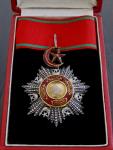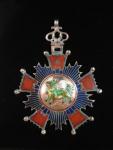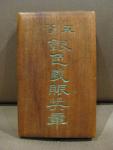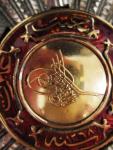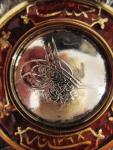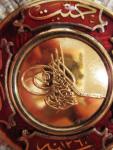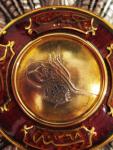-
Posts
851 -
Joined
-
Last visited
-
Days Won
3
Content Type
Profiles
Forums
Blogs
Gallery
Events
Store
Everything posted by drclaw
-
Hey Lorenzo, your collection has me green with envy. What a magnificent collection! I have become a real fan of Garrard & Co and managed to visit their store on Albermarle Street in London recently. They didn't have any Orders on display but the same exceptional workmanship is evident in their contemporary jewellery. Was very tempted to bring some bling home with me even if they were meant for ladies. http://www.garrard.com/ It's an interesting point you make about the pricing of some dealers. I recognise that folk have to make a living (auction houses take a 40% cut from each sale - 20% from the buyer, 20% from the seller). But some of the prices are just extreme. It really turns me off buying from those dealers or even looking at their websites. Auctions might be a more dependable indicator of 'market value' although that doesn't preclude two steel tycoons engaging in a bidding war where egos are more at play than common sense.
-
Gents, just wanted to say thanks for an absolutely fascinating topic. I've been following the posts and this has to be one of the most educational topics in a long while! Cheers to all :cheers:
-
Thanks for putting this up Jean-Paul. A very interesting Order and recipient indeed. I couldn't help also looking at some of the Chinese coins they had on offer - including a gold coin marking the inauguration of 'Emperor' Yuan Shi-Kai! On a general point, do any members aware if the same cultural export restrictions for China apply to the Hong Kong SAR?
-
Hello Avsar, Thanks for that very interesting infromation about Diamond Cutting. I did notice that my Crimean Era Medjidie to have more 'rounded' detailing of the silver parts whereas those with the Ottoman Mint mark are sharp enough to cut through a cloth if you were cleaning it. The size of my Ottoman Mint 5th Class badge is also considerably larger than the 2nd Class neck badge, 3rd Class neck badge and 4th Class breast badge. Cheers, Gavin
-
Thanks very much Avsar, and I do hope that you might consider writing an article for the OMSA Journal - even if it is a translation of your article for the Turkish numismatic journal. I'd be more than happy to help with the English editting if that would help! That's a very nice offer for an old neck ribbon. I'm very pleased with how your medal and the box (which I bought from Chelsea Militaria in London) displays together. All the best! Gavin
-
Hello Avsar, Thank you for sharing your wonderful knowledge with us all. This is knowledge that only comes with long experience and not information in any book. Even the massive Erureten and Tarihi book on Ottoman ODM provides limited information on the Order of Medjidie (at least in the English language sections). I was particularly interested in your information about the different cases from different periods. I've matched the 3rd Class Medjidie which I picked up from you with a paperboard case with the white satin and printed tughra inside the lid. Could you comment on the period of the medal? It is a later Ottoman mintage but unsure if it is a 1900s award that would match the case. It does dsplay very well though, even if it is not the correct period case. Have you thought about writing an article for the OMSA magazine? It would be a very useful resource for everyone with an interest in these beautiful Orders. Gavin
-

My New Kris..! :) (*** MODERATORS' CHOICE)
drclaw replied to kapten_windu's topic in Swords & Edged Weapons
Very nice! I'd be interested to learn more about the period. Is it an old piece, or a contemporary piece? Also about the spiritual aspects. Gavin -

Brunei: The Most Honourable Order of the Crown of Brunei
drclaw replied to Megan's topic in South East & East Asia
Very nice, thanks for sharing. It's a very understated, elegant design considering how much 'bling' it could have been ... from a wealthy, oil rich country. My other favourite would be the Johore Order of the Crown. -
A recent pick-up from the nice gents at Chelsea Military Antiques. If you are ever in London, their store is well worth a visit. They are located on a side street just off Pall Mall on the western side of Trafalgar Square. Gavin
-
Very nice, Dieter! What period would you place this piece? To my inexpert eye, the shape of the mirror suggests an earlier mintage but the kanji on the case appears almost modern.
-
Another stunning Lion and Sun, Markus! The quality of the European manufactures surpass the Persian ones and this is clearly highlighted here. Gavin
-
The Japanese used Chinese old script on the cases of many of their ODM. And I believe they still do.
-
My goodness, I just realise this is in the Japanese thread, not China ... :blush:
-
Hello Taquito, I'll have a go at the first one with my kindergarden Mandarin .... First three characters (shi yi yue = 11th month); fourth character I can't locate in a dictionary but could be reng = blessings, happiness; last two characters (jiu yue = 9th month).
-
Very nice Dieter! Thanks for getting the Japan forum going again. It was getting very quiet. The silver of the medal is absolutely pristine. It could have walked out of the Osaka Mint yesterday. :beer:
-

Serbia Serbia - Order of St Sava, 4th Class
drclaw replied to drclaw's topic in Southern European & Balkan States
Hello Tom, thanks very much for the offer to purchase the photographs. I think I will pass on the photo as the only connection I have to Bojidar is the calling card that came with the St Sava. So there's nothing really of historical significance that I need to unite with the photo. It was a rewarding research project on my part though and I did think of purchasing the photo as a memento. All the best, Gavin -
Congratulations Markus, it's a stunning piece! The enamel painting of the lion is the most regal I've seen thus far. The Wolfers and Boulanger lions would be my favourite. The depiction of the sun and the rays is also lovely. Another reason to collect these Orders.
-

order of the precious star of the double dragon 2grand1calss
drclaw replied to claretbaron's topic in China
Hi Hugh, glad to be able to finally repay the favour for your help on the Kingdom of Afghanistan Orders. The following is a short extract from the excellent 634 page 2008 UBS Tammann Collection Auction Catalogue, prepared by Michael Autengruber and Gustav Tammann. It is one of the most useful reference guides on Chinese Orders around, as well as ODM generally. Michael Autengruber is truly one of the world's leading ODM experts and his website is My link. Unfortunately, UBS appears to have exited numismatics / ODM and closed their dedicated department, which is a loss for the hobby worldwide. The abstract references a number of earlier studies although tracking these down would be a challenge. OMSA is however considering scanning and making available electronic copies of past journal articles to members. --- abstract from 2008 UBS Tammann Collection Auction Catalogue, page151 --- "The statutes of the Order of the Double Dragon, including full-size illustrations, were printed in Chinese and also in French by Th. Dupuy in Paris in form of a proposal of the Tsongli-Yamen (Premier's office) to the Empress Regent on February 7, 1882; they were imperially approved on the same day. Up to 1908 the order was exclusively for foreigners. The order had 5 classes, the upper three classes being subdivided in 3 grades each. The class and grade designation is written in Man characters on the type I insignia (cf. James Peterson, in The Medal Collector 1963, No.4, p.6ff). The early insignia were made in China, but they were often criticized in the Western World as being below the dignity of Chinese, as being worn only as neck badges (although on beautifully embroidered ribbons) without stars even in the highest classes, as having the size of cow bells, and as being not shiny enough. This led to a number of changes. Sashes were introduced already in 1883 for the 1st and 2nd class which, according to a ecree of 1894, had now to be in gold and to be accompanied by breast stars. These breast stars of the central government were probably all made in St. Petersburg (by Mikhail Bogdanov). - The variety of these Type I insignia was greatly enhanced by the fact that the recipinets of the three lower classes (and of the 2nd class?) could be proposed to the court by Viceroys, Governrs, Generals and other high officials who, however, had to pay for the insignia. This was used particularly by Li Hung-Chang to introduce neck badges of reduced size and of non-standard design. When breast stars were introduced in 1894 the silver stars were frequently ordered in Europe (from, e.g., Halley, Kretly, Lemaitre, Wolfers and Godet) and surmounted by a much reduced, Chinese-made type I badge. - In spite of the decentralized proposals, a central roster of all bestowals were kept in Peking with a running number through all classes. These numbers repeated on the bestowal documents, allow the conclusion that less than 1000 Type-I insignia of all classes were distributed from 1882 to the outbreak of the Boxer Rebellion. The confusing variety of insignia led to a new unified, Chinese-made Type II model which was finally introuced in 1902. No official description of the insignia of Type II is known (see King Kwok, The Order of the PreciousStar of the Double Dragon (2nd Type), in: Journal of the Orders and Medals Society of America, 53 (2002), Nr. 6, p. 3-10). Until the end of the Type II insignia late in 1911 their form has remained quite stable with only some variations in size and in ome other details. But there were also European-made insignia. The class designation in Man characters is in the 7 and 8 o'clock position in the ring about the centre (cf. James Peterson, in: The Medal Collector 1963, No. 4, p.6ff). The running numbers (since 1882) of the bestowal documents show that about 4000 Type-II insignia of all classes were distributed in 1901-1911." Coutesy of UBS, Michael Autengruber and Gustav Tammann -
Gents, this is a Catastrophe Relief Merit Order that I recently picked up from Barbara Radman. Institution date unknown but either Warlord (1911-28) or Nationalist (1928-1949) era. It came with its original wooden case with damaged clasp although not with the original ribbon. It is a Fifth Class example as denoted by the single (here, missing) metal star attached to one arm. According to Borna Barac's excellent Reference Catalogue of ODM, the Order was awarded in five classes with the 1st Class having five attached metal stars on the arms, the 2nd Class with four, the 3rd Class with three, etc.
-

order of the precious star of the double dragon 2grand1calss
drclaw replied to claretbaron's topic in China
Hello Hugh, I'm still on a VERY steep learning curve with these. But an excellent source of information is Chinese Medal Blog: My link I can't comment on the authenticity of this particular example. But on (1), I've seen examples sold by reputable auction houses with a carved coral stone and others with a smooth, polished corol stone. On (2), some sources suggest that patterned dragon ribbons were awarded with the Type 1 Double Dragons, with Type 2 Double Dragons awarded with plain ribbons. However, I've also seen Type 2 Double Dragons with a patterned dragon ribbons. Gavin -

Persia - Order of the Lion and the Sun
drclaw replied to drclaw's topic in Middle East & Arab States
Wow, what a great pick-up! Both the medal and case are in perfect condition. And you're right, it's rare to find a Bertrand Lion and Sun, especially one in its original case. Congratulations, Markus :beer: -
Thanks Paul, that answers my question. I spent the past few days peering with increasing frustration through a magnifying glass. It was only after photographing with a macro zoom that I had an epiphany - they were all identical. You are spot on about the European manufactures. The toughra on the 5th Class Crimean is by far the least comprehensible whereas those with the Ottoman mint mark are clearly defined. I find the variation in the design of the medal particularly interesting. It's a shame that Erureten and Tarihi's excellent book doesn't provide more detail on distinguishing between different periods of manufacture (it might be in the Turkish text ...). Gavin PS. I haven't forgotten my promise to shout you lunch when I'm in London
-
I've just received a copy of 'Ottoman Medals and Orders' by Erureten and Tarihi - a monumental book of over 380 pages of colour photographs. Interestingly, the book includes an illustration of each Sultan's unique tugra or signature. A question I have is: Does the tugra in the centre medallion of the Order of Medjidie reflect the particular Sultan of the time in which the Order was awarded? I have examined a 2nd Class, 3rd Class, 4th Class and 5th Class Order of Medjidie and to my untrained eye, all of the tugras appear the same. In fact, they appear to be that of Sultan Abdulaziz (reigned 1861 - 1876). This includes the 5th Class which does not have an Ottoman mint mark on the reverse which might suggest a Crimean era issue under Sultan Abdulmecid (1839 - 1861). Gavin 2nd Class and 3rd Class below:


